We have oodles of new followers, thanks to the 2021 Spring Stitch Challenge. If you were one of the thousands (yes, thousands!) of stitchers who participated, thank you!! It is truly a joy to be able to share my love of needlepoint with so many people. And speaking of new followers, amongst those new followers are several new stitchers! YAY!! Because there are so many new stitchers in our midst, I think now is the perfect time to take a peek at some of the different types of needlepoint projects…
This week, we’ll begin with canvases that feature an image…
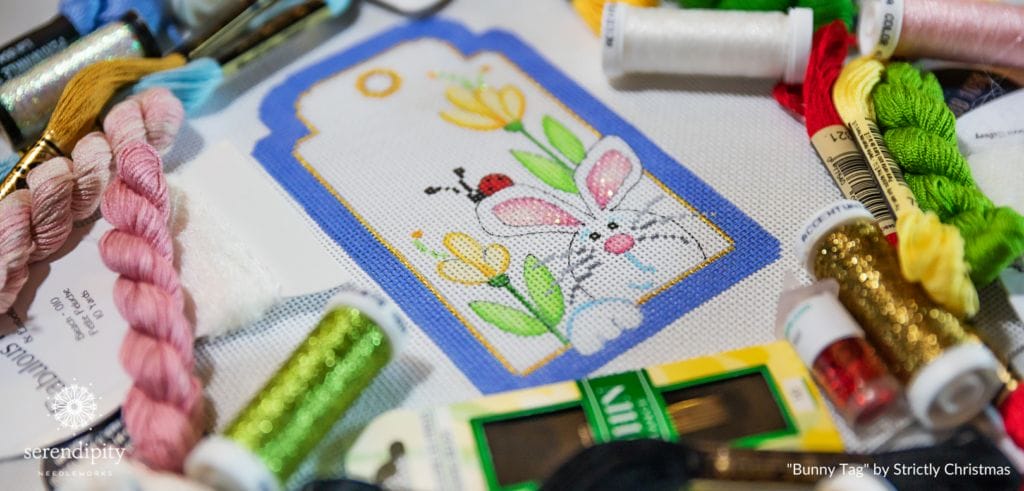
Screen printing and hand painting are the two predominant ways to apply an image to a piece of needlepoint canvas.
Screen printing an image onto a piece of needlepoint canvas is the least expensive method for transferring a design.
Because a machine applies the design to the canvas, though, this method is also more likely to be inaccurate in regard to color placement. Wondering what the heck that means?
Let me shed some light on it for you…
Screen printed designs may look terrific – especially upon first glance. They appear to have oodles of detail. Sounds great, right?! The problem becomes evident when you examine them more closely, though. You may notice that the colors are “muddy” looking. This is the result of the inks running together – or becoming smudged – during the printing process. And you may also find that the design lines are poorly aligned with the grain of the canvas, making it harder to know which color to stitch at each canvas intersection. Finally, all of those details that look super cool from afar can be virtually impossible to stitch.
Some manufacturers do a better job with screen printing designs than others.
My best suggestion is to examine the canvas closely before purchasing – or at least purchase from a source that has a generous return policy if you are ordering via mail.
Elizabeth Bradley canvases are screen printed and they are quite lovely. Other screen printed canvases that I think are particularly well done are those from Beth Russell Needlepoint, Ehrman Tapestry, and Glorafilia Needlepoint.
All of the above companies make their canvases available in kit form. That means you get the thread, needle(s), instructions, and a photograph along with the canvas all in one convenient package. (Elizabeth Bradley kits also include a chart that you can follow in the event that you aren’t sure about which color to place where.)
The Victorian cross stitch is the stitch of choice for Elizabeth Bradley canvases while some of the Glorafilia designs incorporate canvas embroidery stitches to add visual interest. You may also use tent stitch to work any of the designs.
A word of caution – do not assume that kits from Europe will have enough thread to employ the diagonal variation of the tent stitch (a.k.a. basketweave). Instead, plan on using either the half-cross or continental variation. (More about this in today’s episode of Needlepoint TV™!)
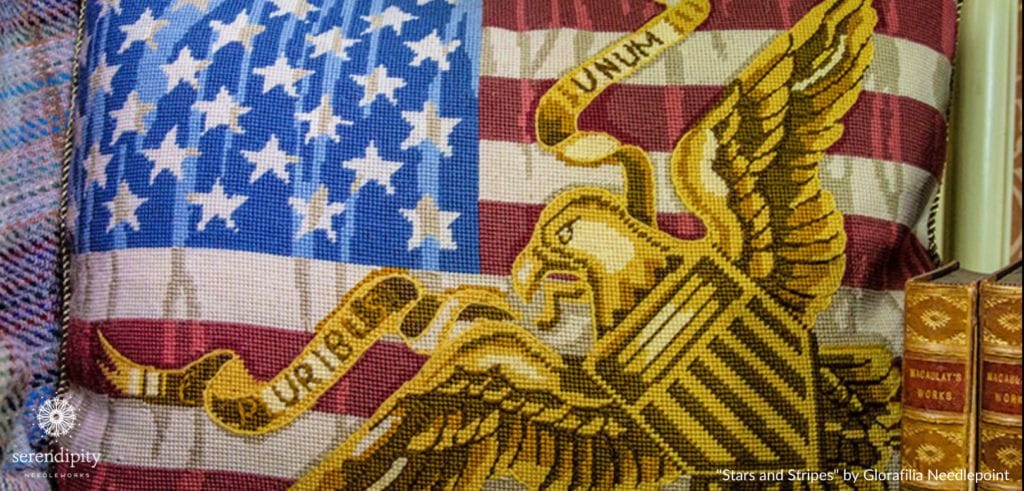
The other type of needlepoint project featuring an image is a hand painted canvas.
Hand painted canvases are exactly what they sound like. An artist/painter applies the design to the needlepoint canvas by hand using a paint brush and acrylic paints. Since an individual paints each design onto a piece of needlepoint canvas, it is easy to understand why these types of needlepoint projects have a higher price tag. They are very labor intensive. What you are actually buying is a piece of art that just happens to be painted on a piece of needlepoint canvas (instead of an artist’s stretched cotton canvas).
Within the genre of hand painted canvases, you’ll find three different types of needlepoint designs.
First, let’s chat about stitch painted designs.
For this type of needlepoint canvas, the artist/painter applies a dot of paint to each canvas intersection so that the stitcher knows exactly which color of thread to use. One of my favorite designers is Sandra Gilmore. Her canvases are available under the Once in a Blue Moon Designs brand. Sandy is a master at stitch painting needlepoint canvases. In my opinion, she is the absolute best at capturing facial expressions. The “Glad Tidings” canvas below is an excellent example of her amazing work…
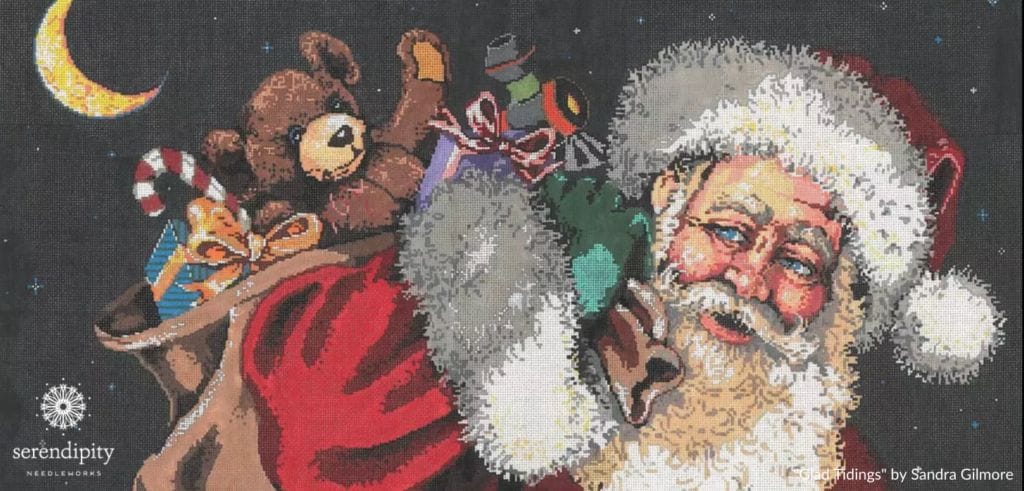
Next up – designs that are artistically painted.
These designs are stunning to look at – and they can be a royal pain in the rump to stitch. Why’s that? Because they are not painted with the stitcher in mind. At least, I don’t think they are. Many times, you’ll find two (or more!) colors brushed across a single canvas intersection. That leaves the stitcher with the task of trying to sort out which color of thread to use.
Liz Goodrick Dillon’s designs (Tapestry Tent) come to mind first when I think of artistically painted needlepoint canvases. They are absolutely gorgeous – and quite challenging to stitch – especially for beginning stitchers.
Here’s an example for you…
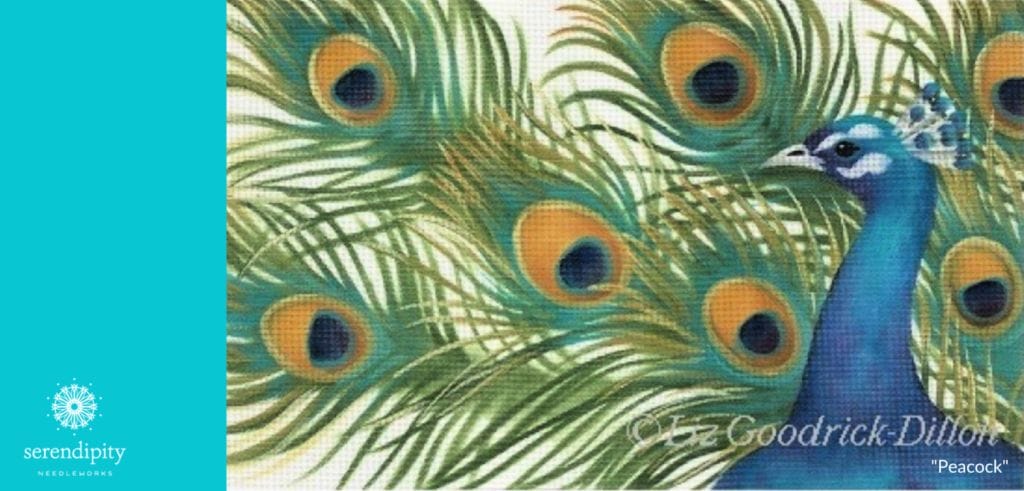
And finally, you’ll find needlepoint designs that are a combination of stitch painting and artistic painting.
These types of needlepoint designs are probably the most common. They include both stitch painted segments and artistically painted segments. Kelly Clark Needlepoint employs this method a lot, as do several other designers, including Pepperberry Designs and Maggie and Co.
This bunny rabbit Easter egg canvas is a terrific example of the combination approach to painting needlepoint canvases. Notice how all of the design components are stitch painted except the tulips. Those tulips are artistically painted (and shaded!) so that the stitcher will have to make some decisions about which color of thread to use on several of the canvas intersections.
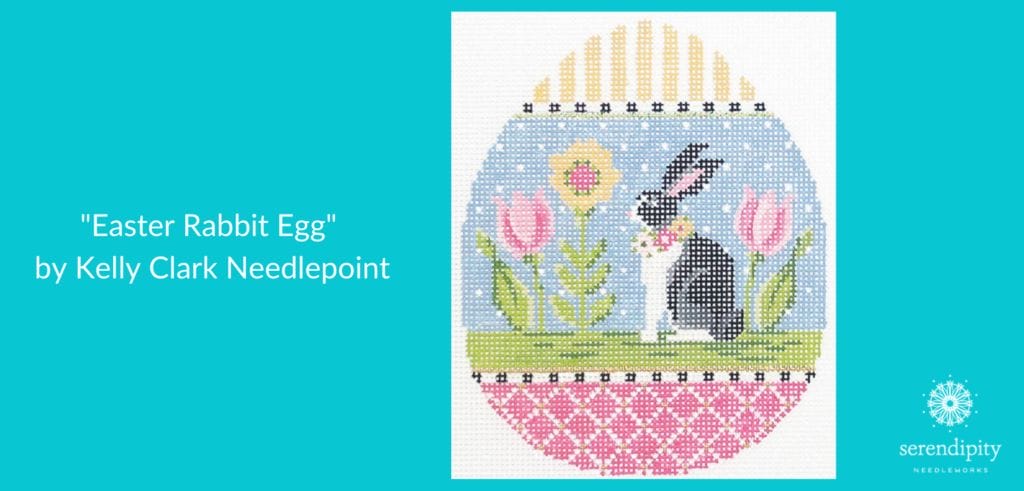
Most hand painted needlepoint canvases are sold “as is” – without threads.
But you can always ask your local needlework shop to pull threads for you. I’m sure they’ll be more than happy to assist. And if you want to try your hand at using decorative stitches, but don’t think you’re quite ready to choose them yourself, you might also ask for some suggestions from the shop staff. I’d be willing to bet they’ll jump at the chance to pitch in and help. 😉
One more thing to consider…
Oftentimes, you’ll find collaborative partnerships between shops and designers (and, many times, those types of needlepoint projects will even include a stitch guide!). Clubs are also quite popular. That’s where you stitch several pieces of a designer’s line as part of a collection or series. For example, sea creatures or 12 Days of Christmas ornaments. Typically, you’ll receive one needlepoint project each month (or every other month) over a specific period of time.
Of course, you know that I’m going to advocate that you put your own unique creativity to work on your different types of needlepoint projects. You can do that through your selection of threads and by using decorative stitches to add texture, dimension, perspective – and more!
If you’re new to needlepoint…
you’ll likely want to establish a rock-solid foundation for your needlepoint hobby before you delve into using decorative stitches, though.
Next week, we’ll chat about the other types of needlepoint projects, including counted canvas needlepoint and line drawn needlepoint.
Thank you ever so much for dropping by for a visit with me today.
I hope you have a wonderful rest of your week and I’ll see you again soon…
XOXO!!

PS: What’s your favorite kind of needlepoint to stitch? I’d love to know, so tell me in the comments box down below. 🙂


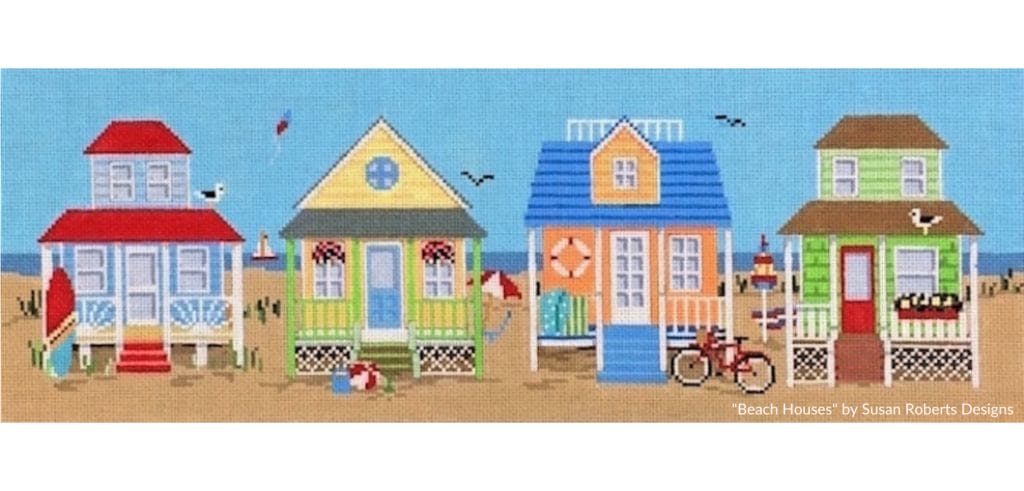


My favorite canvas designs are art deco.
🥰🥰🥰
I HATE shaded areas of canvases. I can never see what color to use and thus my frustration hits a high boil. These canvases, for me, become my UFOs, and I finish them years after starting .I prefer exact color placement and use different thread choices to make statements.
Heavily shaded canvases can be challenging, for sure! If you’ve never tried it, you might consider making a black and white photocopy of your canvas (before stitching it) to help you see the different values of color. That can help with knowing where to change hues. 😉
Happy stitching…
Ellen
Hello, Ellen: I have been chasing your ads all over FB and appreciate your professionalism, knowledge and your products. I don’t know if anyone else has asked you this before. Do you have any discounted beginning learner programs for seniors? I am 88 years old and my bent and curled fingers have kept me from going back to crocheting. I have been wanting to get into cross stitching and have embroidered before.
Hi Dollie
Thank you for reaching out. I’m so sorry for my delayed reply. Somehow, I missed your message. Someone from my team will reach out to you next week. 🙂
Happy stitching!!
XOXO!
Ellen
Can you recommend a designer to paint custom designs? I want to pull together several images for some Christmas ornaments, a custom men’s belt, & a cocker spaniel canvas for a small foot stool.
Hi Ellen
My best suggestion is to reach out to Rittenhouse Needlepoint. I believe they still offer the services you’re looking for.
XOXO!
Ellen
I have a canvas that I call 5 women with hats. I plan to use my stash with this canvas. I need suggestions for what stitches to use. While I can decide on some myself from previous work. I would like suggestions. Is this something you could for me if I sent a picture of the canvas. Please let me know.
Hi Rhoda
Thank you for your note. Your canvas sounds lovely! While I’m not able to provide the kind of assistance you’re asking about at the present time, I do teach people how to become self-sufficient in choosing their own stitches and threads for all of their canvases in my membership program called The Stitcher’s Club. If you’d like to learn more about it, please send an email to [email protected]. 🙂
XOXO!!
Ellen